PARTICIPATION OF THE NWO EECCA IN THE INBO EUROPEAN CONFERENCE FOR THE IMPLEMENTATION OF THE EUROPEAN WATER FRAMEWORK DIRECTIVE
Megeve, France, September 22-24, 2010
The delegation of the new Network of Water Organizations from Eastern Europe, Caucasus, and Central Asia was invited by the INBO Secretary General Jean-Francois Donzier to a regular INBO European Conference that was held in South France, in the picturesque winter resort of Megeve, 75 km far from Geneve. The delegation was comprised of:
Academician Polad-zadeh P.A. – Network President;
Prof. Dukhovny V.A. – Network Executive Secretary;
Board of Directors’ members:
Prof. Prokhorova N.B. – Director, Russian Research Institute of Multipurpose Use and Protection of Water Resources, Russian Federation
Prof. Kovalenko P.I. – Director of Institute of Hydraulic Engineering and Land Reclamation, Ukraine
Prof. Kalinin M.Yu. – member of the Network’s Board of Directors, Byelorussia
Prof. Karlykhanov T. – member of EC IFAS, Kazakhstan
Bednaruk S.Ye. – Director of Center for Russian Waterworks Inventory and State Water Cadastre, Russian Federation.
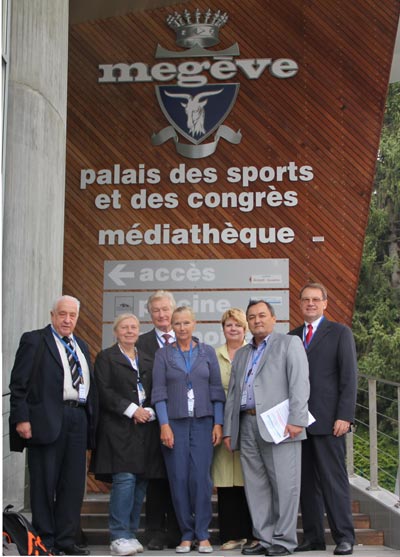
The Conference was held simultaneously with the 3rd International Congress on «New water governance in mountains is needed to face climate change!» and involved discussion of the European INBO with the representatives of all regional INBO.
More then 600 people, including 177 members of “Europe-INBO” participated at the Conference.
The participants were welcomed by the Mr. Jean-Paul Amoudry, Senator, President of the Alpine Economic Company of Upper Savoy, the presidents of the several water agencies from France, Spain, and Portugal, the Commissioner to the protection against floods at the Hungarian Ministry for Rural Development, Mr. Jean Claude Vial, Deputy Director of Water and Biodiversity, French Ministry of Ecology, Energy, Sustainable Development and the Sea, and Mrs. Danielle Mitterrand, President of the Association «France Libertes» and spouse of the late President of France Mitterrand. Prof. Dukhovny V.A. read out the welcome speech of Mr. Polad-Zadeh P.A. on behalf of the newly established Network.
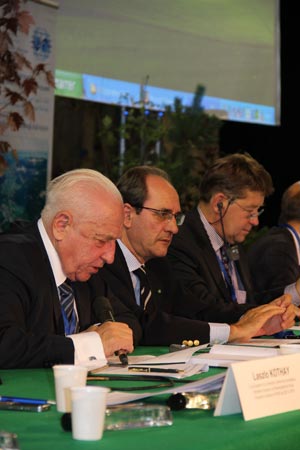
The participants from European countries and from other regional networks of INBO have presented their efforts in improving their water sectors in compliance with the European Water Framework Directive (WFD). Particular attention was paid to a need for consideration of permanent impact of climate change.
Since 2000, the European Water Framework Directive has become a unique driver on a scale of the whole Europe for restructuring and reformation of water management. 170 river basin districts were established, and 40 of those districts are transboundary that cover more than 60% of Europe’s area.
Two important goals were set:
- the Management Plans of all these basin districts should be completed by December 22, 2009;
- all members of the European Union should report by March 22, 2010.
16 countries have already published their plans: France, Great Britain, Netherlands, Greece, Luxemburg, Czech Republic, Slovenia, Austria, Italy, Bulgaria, Romania, Latvia, Finland, Switzerland, and Hungary. The international plans were prepared for Danube, Rhine, Elbe, Ems, Maas, and Schelde.
Good experience of WFD implementation is shown in the Schelde river basin, which covers the estuaries of Rhine, Meness, and a number of other rivers, where interests of the two regions in Belgium (Flanders and Wallonia), the Netherlands, and Luxemburg are closely interlinked and not conflicting, thus enhancing cooperation of the riparians in this unique area for protection from floods and utilization of water. In this area, the density of population is 350 persons/km2.
Within the framework of this program, an IWRM Coordinating Committee was established among representatives of the three states. In turn, the Committee created a special work group, which focused on:
- flood control;
- adoption of environmental services;
- maintenance of ecological wellbeing and prevention of its deterioration in the long-term.
The Center for restoration of channels along tributaries and flows was established as well.
Major attention is paid to involvement of young people through schools, universities, and NGOs.
At present, France, as well as neighboring basin authorities joined to the Program.
According to WFD, France has developed the “Plans of Environmental Improvement” for all national river basins. The plans stipulate that water use in the country as a whole should be reduced by 15% and a scale of cleaning of river channels and other water bodies should be increased considerably. 50% of river basins have already achieved the goal of the good state of river bodies. Besides, the Ministry of Environment additionally stipulated that “Plans for overcoming risks” should be developed for all basins. The Ministerial inspection (30 thousand inspection trips over 2 years) has found that 37.5% of districts did not confirm the good state of water and required additional measures, especially in terms of industrial wastes.
The Corsica Agencies shows an example of successful work among basin water agencies. Within the island, a Water Parliament was organized, a Public Water Committee comprising 165 people, which oversees implementation of the Basin Development Plan (SDAGE). Over 2007–2010, 3 billions Euro were spent for this purpose.All the countries pay increased attention to the economic mechanism of water conservation. As a result, for example, given the population of 62 million people, domestic-household water use has dropped to 6 billion m3 a year or less than 300 liters/capita/day throughout France. However, it is planned to reduce this figure further to 220 liters by 2020.
The Mediterranean Network of Basin Organizations (MENBO) advances a slogan "Aqua madre" ("Mother – water"), which is based on general understanding of a need for solidarity in water use and management. All the Mediterranean countries, except for Egypt, follow strictly this line of conduct. However, the water use situation in the East – Israel, Lebanon, Syria, Jordan, and Palestine – is quite serious. Lebanon suffers most in terms of water security and environmental state of water bodies. Nevertheless, the Conference found that implementation of WFD is quite complicated, even in France there are not enough funds for fulfillment of the whole program to achieve the goals set.
A special meeting of non-European membership of INBO was dedicated, mainly, to reports by our new network of Eastern Europe, Central Asia, and Caucasus. The meeting was chaired by Sergey Bednaruk, Director of Center for Russian Waterworks Inventory and State Water Cadastre, Russian Federation.
Prof. Dukhovny V.A. made an introductory presentation on goals, objectives, and approaches to addressing of regional problems. He also demonstrated results of the Network’s activity over one and a half year from its establishment. Prof. Dukhovny also expressed this thanks to the UN European Economic Commission (UNECE) and the Swiss Development and Cooperation Agency (SDC) for financial and organizational support.
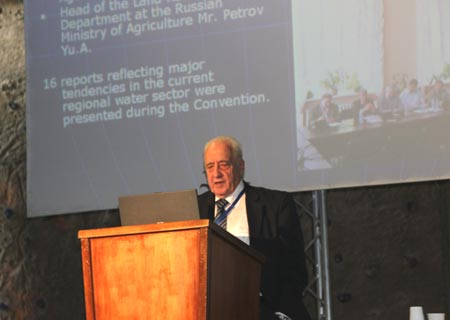
The automation of the control system for Dnieper river between Ukraine and Byelorussia and the remote flood control system along the Tisza river (Hungary) are under development and a program for radical improvement of national water management is planned.
Prof. Kovalenko P.I. in his report focused on the problems in the Ukrainian water sector, the poor public and stakeholder participation in water management and use, and the lack of funding for modernization and reconstruction of irrigation systems. The country has 7 international partners, with whom treaties were signed. The partnership between Russia and Ukraine on the North Donets river basin is a good example of cooperation, where water management follows to WFD scenarios.
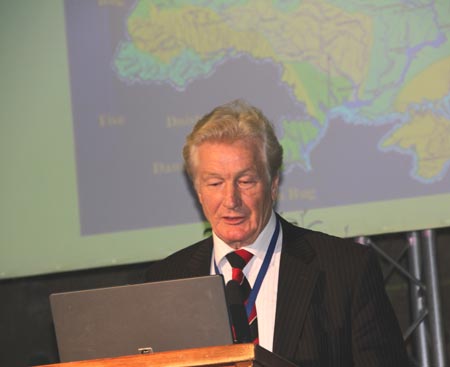
Byelorussia, as mentioned Prof. M.Yu.Kalinin in his report, has it own transboundary problems on five large rivers. Conclusion of bilateral agreement with Poland, Russia, Lithuania, and Latvia is delayed due to conditions over which the country has no control. The meetings of international work groups on transboundary watercourses are irregular. This year the National Government has approved the National Water Use Strategy. In 2009, the Government started to develop a plan for integrated water use and management in the Niemen river basin. Moreover, the inventory of national water bodies is close to completion. Besides, he underlined a need for transfer from administrative boundary-based approach to basin water management.
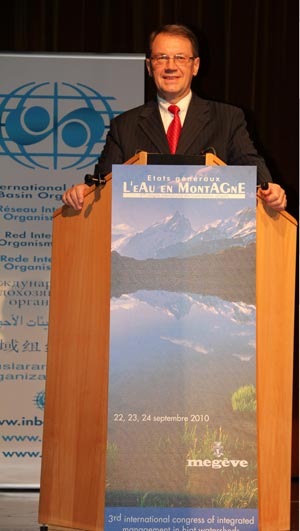
Although Russia is one of water-rich countries, plenty of small and medium-size rivers creates local water deficits. An interesting report by N.B.Prokhorova demonstrated application of result-oriented approaches in basin management through the Tuzlov river case-study in Rostov province. Moreover, principles applied in the management are based on the development of basin management plants that are similar to WFD plans and involve basin approach, minimized negative effect, water charges, and public participation.
A very interesting report on adoption of basin approach in the Russian Federation was presented by S.Bednaruk. In 2006, the hydro-environmental and hydrographic zoning of the country was made. It included 20 basin districts, 66 hydrographic units, 85 sub-basins, and 133 unique hydrographic units. Using the Lena river case-study, he showed adoption of this approach in practices of water-management agencies.
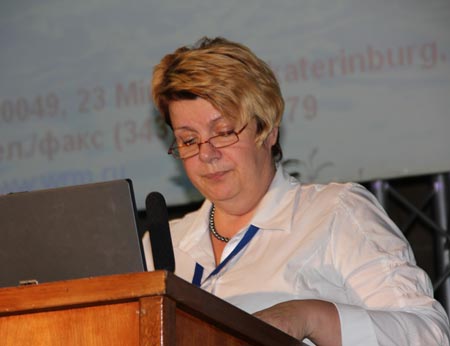
A very interesting report on adoption of basin approach in the Russian Federation was presented by S.Bednaruk. In 2006, the hydro-environmental and hydrographic zoning of the country was made. It included 20 basin districts, 66 hydrographic units, 85 sub-basins, and 133 unique hydrographic units. Using the Lena river case-study, he showed adoption of this approach in practices of water-management agencies.
Georgy Arzumanyan, Director of the Caucasus REC showed the complex situation related to transboundary water sharing in Transcaucasia. Major problem is connected with the Kura and Arax basin, which is shared by 3 Caucasus countries plus Turkey, Russia, and Iran. Here, water quantity and quality problems, shortage, and flood control problems are also notable .
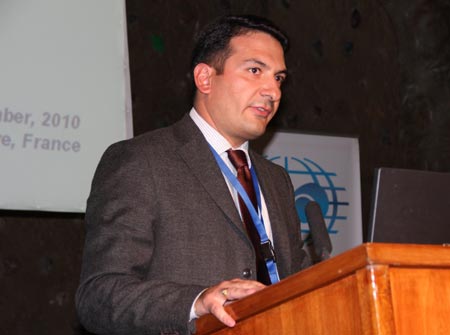
The Alpine Convention is an interesting example, where a Water use agreement extends its scope and monitoring far beyond the water sector. The Convention was signed in 1991 by eight states located in Alps and the European Commission. Its aim was to ensure sustainable development of the Alpine area and protect interests of its inhabitants, taking into account environmental, social, and economic interests to wide extent. In this context, WATER is one of the main subjects of the Convention, which stipulates conservation or restoration of healthy aquatic systems, protection of lakes and rivers from pollution, and use of environmentally suitable engineering structures. The Convention is based on the balance of local interests and environmental requirements, with account of generation of energy, irrigation, drinking water supply, as well as development of biotopes, particularly forests, biodiversity, and natural and cultural landscapes.
Since signing of the Convention, a lot of changes have occurred concerning growth of water demand and variation of water availability due to climate change. An interesting target group was established. It was comprised of the representatives from Austria and Germany – the two key parties of the Convention – and the other important stakeholders, including scientists, majors, NGOs, etc. Basic recommendation for measures required and major aspects of water management improvement were developed. Those are focused on the following directions:
- The Alps are the “Europe’s water tower”, management of which impacts flow regimes of such rivers as Danube, Rhine, Rhone, and Po, as well as flow in other small rivers that receive from 35 % (Danube) to 80 % (Po) of water from it; in-stream demand and stability of those rivers is an objective of water management;
- water management should consider a number of “destabilizing factors”: the demographic load of 14 million people, which increases by 8% over 20 years; agricultural land use, which should keep limits set for fertilizer and chemical application; tourism with its increasing flow of tourists; energy demand and thus construction of new hydropower structures, both small and quite large, which particularly becomes intensive due to current rise in energy prices;
- development of the in-depth information system on Alpine water, including both surface water and groundwater; this system should be organized in such a way so that to meet the requirements of the European water initiative, particularly regarding water quality monitoring;
- obligatory cleaning of water discharged into natural sources, avoiding discharge of any pollutants (the whole mountain massif of Alps is covered with treatment stations), including control and treatment of non-point sources;
- combating periodic droughts, especially during 2002-2007, as well as organizing flood control and bank protection against erosion.
Great attention is paid to such tools that influence the sustainability of water management. In the first place this is underlined in legal rules. Though water is viewed as a common heritage in Italy, France, and Switzerland, there is a right of place, where given water source occurs; a certain form of permission for all uses, with obligatory licensing of water rights; responsibility for keeping water quality. In addition, implementation of IWRM is a form of protection and guarantee of the sustainability of water supply for all stakeholders through their involvement. Charges for water supply ("user pays principle") are obligatory as well. All water uses that change natural flow regimes are under special control. First of all, those are hydropower, offtake installation. Such uses should pay the so-called “compensatory payment” for nature protection and support.
Despite more than 500 existing HEPS with the capacity of more than 10 MW in the Alps, construction of new HEPS is a subject of serious public discussion. The European Water Framework Directive sets quite strong limits for hydropower development: it is required that besides undoubted effect of ŃÎ2 emission reduction from electricity generation, environmental requirements and downstream users are fully considered as well. Moreover, as Berlin meeting in 2007 concluded, both local and basin effects from new construction had to be considered and all stakeholders should participate in the assessment of this construction. In addition, priority should be given to small and micro hydroplants.
Organization of work on natural disasters is of great importance. The Alpine Convention’s Secretariat has organized a platform "PlanAlp – Natural Disasters", which prepared recommendations for prevention and mitigation for all the countries. Among those measures, risk management is the major, as well as land use planning, afforestation, early warning systems, natural flow rehabilitation, bank protection, and damage mitigation. It was proposed to bear in mind that such negative phenomena could become more frequent due to climate change and consider a need for revision of earlier planned measures.
As a whole, participation of EECCA NWO’s delegation in this event was very useful for understanding of water development ways in Europe and for enhancement of relationship with international water and environmental institutions.
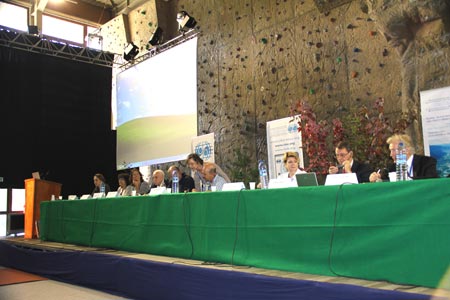
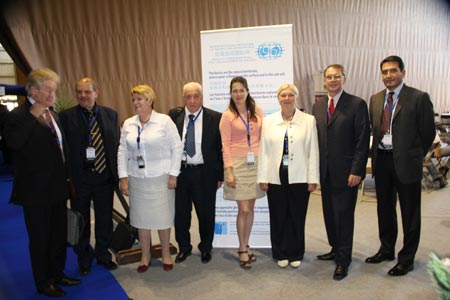
Prof. V.A. Dukhovny
Director, SIC ICWC
|